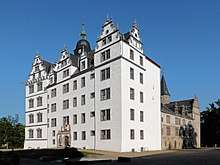Wolfsburg
Wolfsburg (UK: /ˈvɒlfsbɜːrɡ/ VOLFS-burg,[2] US: /ˈwʊlfsbɜːrɡ, ˈvɔːlfsbʊərk/ WUULFS-burg, VAWLFS-boork,[3][4] German: [ˈvɔlfsbʊɐ̯k] (![]()
Wolfsburg | |
|---|---|
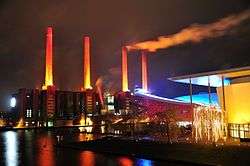 VW power station at night | |
 Flag 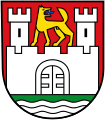 Coat of arms | |
Location of Wolfsburg in Lower Saxony  | |
 Wolfsburg  Wolfsburg | |
| Coordinates: 52°25′23″N 10°47′14″E | |
| Country | Germany |
| State | Lower Saxony |
| District | Urban district |
| Subdivisions | 16 Ortschaften, 40 Stadtteile |
| Government | |
| • Lord Mayor | Klaus Mohrs (SPD) |
| Area | |
| • Total | 204.02 km2 (78.77 sq mi) |
| Elevation | 63 m (207 ft) |
| Population (2018-12-31)[1] | |
| • Total | 124,151 |
| • Density | 610/km2 (1,600/sq mi) |
| Time zone | CET/CEST (UTC+1/+2) |
| Postal codes | 38400–38448 |
| Dialling codes | 05361, 05362, 05363, 05365, 05366, 05367, 05308 |
| Vehicle registration | WOB |
| Website | www.Wolfsburg.de |
In 2013, Wolfsburg ranked as the richest city in Germany with a GDP per capita of $128,000 due to its thriving auto industry.[5]
Wolfsburg is famous as the location of Volkswagen AG's headquarters and the world's biggest car plant. The Autostadt is a visitor attraction next to the Volkswagen factory that features the company's model range: Audi, Bentley, Bugatti, Ducati, Lamborghini, MAN, Neoplan, Porsche, Scania, SEAT, Škoda Auto and Volkswagen Commercial Vehicles. Wolfsburg is one of the few German cities built during the first half of the 20th century. From its founding on 1 July 1938 as a home for workers producing the "KdF-Wagen" (VW Beetle) until 25 May 1945, the city was called "Stadt des KdF-Wagens bei Fallersleben". In 1972, the population first exceeded 100,000.
Geography
Wolfsburg is located at the Southern edge of the ancient river valley of the Aller at the Mittellandkanal (Midland Canal). It is bordered by the districts of Gifhorn and Helmstedt.
Climate
The total annual precipitation is about 532 mm (21 in) which is quite low as it belongs to the lowest tenth of the measured data in Germany. Only 7% of all observation stations of the Deutscher Wetterdienst (German Weather Service) record lower measurements. The driest month is October, most precipitation is measured in June where observation stations measure 1.9 times more precipitation than in October. Precipitation hardly diversifies and is constantly distributed all over the year. Only 17% of observation stations measure lower annual deviation.
History
The castle "Wolfsburg" was first mentioned in 1302 in a document as the domicile of the noble lineage of Bartensleben. Originally a keep next to the Aller, it was protected by a moat some centuries later. In 1372, the first documentary reference to the Burg Neuhaus (castle of Neuhaus) near Wolfsburg appeared. After the extinction of the Bartensleben line in 1742, the property and its Schloss Wolfsburg (Wolfsburg Castle) passed on to the Counts of Schulenburg. The communal manor was an important employer for the nearby settlements Rothenfelde and Heßlingen.
Some of today's urban districts, including Vorsfelde and the villages transferred to Wolfsburg from the county of Helmstedt, belonged to the Principality of Brunswick-Wolfenbüttel. Fallersleben and other villages belonged to the Electorate of Braunschweig-Lüneburg, which later developed into the Kingdom of Hanover and became a Prussian province in 1866. Other urban districts, including Heßlingen, belonged to the Prussian Duchy of Magdeburg. In 1932, these districts were detached from the Prussian Province of Saxony and integrated into the Province of Hanover.
Wolfsburg was founded on 1 July 1938 as the Stadt des KdF-Wagens bei Fallersleben (English: City of the KdF Car at Fallersleben), a planned town centred around the village of Fallersleben, built to house workers of the Volkswagen factories erected to assemble the Volkswagen Beetle. During World War II military cars, aeroplanes, and other military equipment were built there, mainly by forced workers and POWs.. In 1942, German authorities established the Arbeitsdorf concentration camp in the city for a few months. A minimum of six individuals died while working at this camp.
At the urging of the British occupying power, the city was renamed as Wolfsburg on 25 May 1945, after the eponymous castle located there. In 1951, Wolfsburg was separated from the District of Gifhorn, and became an urban district.
In 1955 the one-millionth VW Beetle was manufactured in Wolfsburg. Postwar Beetle production ended in Wolfsburg in 1974, though German Beetle production continued in Emden until 1978. The factories in Wolfsburg remain a key part of Volkswagen's production capacity.
During the German economic miracle Wolfsburg experienced a large influx of immigrant workers, especially from Italy.
In 1958 the city hall was built. In 1960 the Volkswagenwerk GmbH (limited partnership with a limited liability) was changed into an AG (public limited company).
In the course of a land reform in Lower Saxony in 1972, 20 localities were added to the city through the "Wolfsburg-Act". Wolfsburg gained the status of major city with nearly 131,000 inhabitants. The city's area grew from 35 to nearly 204 square kilometers. In 1973, the city's population peaked at 131,971.
In 1982 the A39, a side road of the A2 (Oberhausen - Hannover - Werder), was built as a direct freeway to Wolfsburg.
In 1988, the city became a university town with the establishment of the University of Applied Science Braunschweig/Wolfenbüttel. Today its name is Ostfalia University of Applied Science.
As a launch promotion for the 5th generation of the Volkswagen Golf the city of Wolfsburg welcomed visitors on the internet, on the official stationery, and on every city limit sign with the name "Golfsburg" from 25 August to 10 October 2003. This campaign gained the nationwide attention of press, radio, and TV broadcasting.
In the summer of 2009, Wolfsburg gained nationwide attention when their football team, VfL Wolfsburg, won the German football league. A party was held in the city centre with about 100,000 people, and was a first in the history of the city.
Culture and attractions

The centre of Wolfsburg is unique in Germany. Instead of a medieval town center, Wolfsburg features a new and modern attraction called the Autostadt. The old part of the town Alt Wolfsburg (de) shows some manor buildings in traditional framework style. Atop a hill by the River Aller is the Wolfsburg Castle.
The Autostadt is an open-air museum-theme park dedicated to automobiles owned and operated by Volkswagen. In the center of the park are the pavilions featuring Volkswagen's major brands: Volkswagen and Audi to the north, further south are SEAT, Škoda Auto, Lamborghini, Bentley, Bugatti and the Premium Clubhouse. Right next to the lagoon is the Porsche pavilion. The striking Volkswagen Commercial Vehicles pavilion is in the south-east of the park. The Autostadt also includes: a planetarium; a Ritz-Carlton hotel; the Phaeno Science Center, the largest hands-on science museum in Germany; a water skiing resort; and a private art museum (Kunstmuseum Wolfsburg) specialised in modern and contemporary art.
Another major attraction is the Wolfsburg Water Show, the world's largest water-flame-laser-video fountain show with its up to 70 meter high fountains.[6]
Population development
From about 1,000 inhabitants in 1938, the population of the city increased to 25,000 in 1950 and doubled to 50,000 until 1958. On 1 July 1972, the population of Wolfsburg first went beyond the mark of 100,000 because of the suburbanization of several villages which made Wolfsburg a major city. In 1973, the population reached its highest level: 131,971. At the end of December 2010, 121,451 people were registered with their principal residence in Wolfsburg. Until the end of 2012, this number climbed to 123,144.
| Rank | Nationality | Population (31.12.2018) |
|---|---|---|
| 1 | 5,506 | |
| 2 | 1,469 | |
| 3 | 1,349 | |
| 4 | 682 | |
| 5 | 563 | |
| 6 | 521 | |
| 7 | 475 | |
| 8 | 450 | |
| 9 | 450 | |
| 10 | 403 | |
| 11 | 326 | |
| 12 | 310 | |
| 13 | 308 | |
| 14 | 261 | |
| 15 | 259 | |
Organization
The city of Wolfsburg is organized into 40 districts. One or more districts make up one of the total of 16 localities which are represented by their own councils. Every council has a local official as its mayor.
First the councils were only established in the 11 localities suburbanized in 1972. They partly took over the functions of the former town councils of each of the districts. In 1991 and 2001 some of the localities were split into smaller areas so that today there are 16 localities, each with its own council which are directly voted by the citizens.
The only exception from this organization is the Allerpark (Aller Park), a local recreation area surrounding the Allersee lake, and the area of the Volkswagen factory which are both located in the central city area.
The administrative area of Wolfsburg includes six nature reserves. Five of them are located in the ancient Aller river valley.
Politics
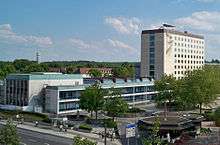
Head of the young "Stadt des KdF-Wagens" became the government assessor Karl Bock on enactment #145 of the chief president of the government of Lüneburg effective from 1 July 1938. His followers were also deployed by the government.
In 1946, the military government of the British zone of occupation established a communal constitution following the British example. After this, citizens voted for a council which elected a volunteer mayor/ lord mayor as the city's leader and representative. After 1946, the council elected a full-time director to lead the city council. In 2001, the city council's dual leadership was abolished. It is led by a full-time lord mayor who is also the city's representative, Klaus Mohrs. Since 2001, citizens directly elect the lord mayor. The council still has its own chairperson elected by the council's constitutive conference after every local election.
The city has been described as a “social democratic utopia”.[7]
City council
The city council is made up of the fractions of the different parties (47 seats) and the lord mayor with one seat. The lord mayor is head of administration, thus the superior of all employees of the city council. The lord mayor is supported by four departmental heads that are voted by the council on his proposal. Together, they make up the board of directors of the city administration where the most important decisions concerning administration are deliberated weekly.
Results of the local elections on 11 September 2011:[8]
| Party | Seats | Votes (%) | Votes |
|---|---|---|---|
| SPD | 17 | 37.7% | 53.355 |
| CDU | 14 | 31.6% | 44.635 |
| PUG | 5 | 11.9% | 16.769 |
| Bündnis 90/Die Grünen | 5 | 9.9% | 14.026 |
| PIRATEN | 2 | 3.9% | 5.528 |
| FDP | 1 | 2.4% | 3.326 |
| Wolfsburger Linke | 1 | 1.5% | 2.106 |
| WTZ | 1 | 1.2% | 1.673 |
Voter participations: 49.4%.
Emblems
Wolfsburg's emblem shows a silver two-tower castle with a closed gate on red ground over a green base with silver waved timbers. A golden wolf with a blue tongue paces over the castle's battlement. The city's flag is green and white.
Lower Saxony's Department of the Interior awarded the city of Wolfsburg's emblem in 1952 after it had been constituted in the association articles in 1947. In 1961, it was improved heraldically and newly awarded by the governmental executive committee of Lüneburg. The symbols of the wolf and the castle reflect the city's name (canting arm) and do not have a historical, directly conveyed reference. The flag was adopted in 1955.
Volkswagen used a modified version of the Wolfsburg coat of arms as its steering wheel emblem, (and occasionally as a hood ornament, on classic Beetles) until the early 1980s, when it was replaced by the VW roundel.
Regional authorities
The city of Wolfsburg is a member of the association Braunschweigische Landschaft e.V. with a registered office in Braunschweig and in the Lüneburgischen Landschaftsverband e.V. with a registered office in Uelzen. These associations were founded to foster cultural establishments of the regions.
Architecture

Historical castles
- The Schloss Wolfsburg (castle of Wolfsburg), a Weser renaissance castle of the 13th century was first documented as the domicile of the noble lineage of Bartensleben in 1302. As the city is named after this castle, it is Wolfsburg's landmark.
- The Burg Neuhaus (castle of Neuhaus) is a medieval moat from the 14th century which has been owned by the city government since 1981.
- The Schloss Fallersleben (castle of Fallersleben) was completed in 1551. Since 1991 it has housed the Hoffmann-von-Fallersleben-Museum.
Museums
- The Kunstmuseum Wolfsburg (Art museum Wolfsburg) is internationally renowned and has shown contemporary and modern international art since 1994
- The Städtische Galerie (Municipal Gallery), located in the Schloss Wolfsburg (castle of Wolfsburg) shows multifarious pieces of contemporary art
- The AutoMuseum Volkswagen was opened in an old textile factory in Heßlingen in 1985
- The Stadtmuseum Wolfsburg (Town Museum) is a modern museum with an exhibition about the history of the castle, the region and the city. It is located inside the castle of Wolfsburg.
- The Hoffmann-von-Fallersleben-Museum in the castle of Fallersleben shows the history of German poetry and democracy, especially focused on the life of Hoffmann von Fallersleben between 1798 and 1874.
- The Heinrich-Büssing-Haus in Nordsteimke was opened on the initiative of the MAN-group in the house of Büssing's birth in 1988. It shows the life of Büssing and the development from craft to industry.
- The Burg Neuhaus (castle of Neuhaus) is a moat showing an exhibition of models of the castle and the water mill, late medieval weapons and documents concerning the life of people of the time before 1800.
- The Autostadt is, after Disneyland Paris, the most visited theme park in Europe. The theme is (auto) mobility.
- The Phæno is a science center with 250 experiment stations on an exhibition space of nearly 6,000 square meters. The unique architecture was designed by Zaha Hadid.
- The Romantikpark Landleben (theme park Romantik Park Landleben) in Kästorf shows a historical Lower Saxon village combined with parks and restaurants.
Sport

The most famous professional sports club in the city is VfL Wolfsburg, established in 1945. The men's football team won the Bundesliga in 2009, the DFB Pokal in 2015 and the DFL-Supercup in 2015. The women's football team has been even more successful, winning the Bundesliga in 2013 and 2014 as well as the DFB-Pokal in 2013 and 2015. The women's team has also succeeded in winning the UEFA Women's Champions League in two consecutive years, 2013 and 2014.
Wolfsburg is also the home of the ice hockey team Grizzlys Wolfsburg, which since 2007 has made it to a leading position in the German ice-hockey league.
Also based in city is the tennis tournament Volkswagen Challenger, which has been held annually in Wolfsburg since 1993.
International relations
Twin towns - sister cities
Wolfsburg is twinned with:[9]







Wolfsburg has relationships with:








Notable people
- Peter Bialobrzeski (born 1961), photographer
- Dero Goi (born 1970), musician
- Stefanie Gottschlich (born 1978), footballer
- Karin Janke (born 1963), sprinter
- Wolfgang Müller (born 1957), artist
- Sascha Paeth (born 1970), musician
- Amanda Somerville (born 1979), musician
- Rolf-Dieter Postlep (born 1946), president of the University of Kassel 2000-2015
- Wolfgang Dürheimer, president of Bugatti Automobiles
- Liane Winter (born 1942), marathoner[10]
Notable natives
- Hoffmann von Fallersleben, bourgeois August Heinrich Hoffmann (1798-1874), German scholar, linguist, librarian, poet, writer of the German national anthem ("Song of the Germans"), was born and raised in what is now the Fallersleben district
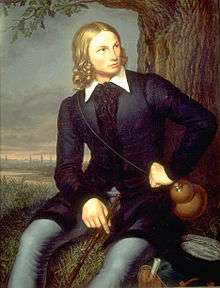 Hoffmann von Fallersleben painted by Schumacher 1819
Hoffmann von Fallersleben painted by Schumacher 1819 - Hanns Kerrl (1887-1941), politician (NSDAP), born and raised in what is now the Fallersleben district
- Rolf-Dieter Postlep (born 1946), born in Wolfsburg, economist and since 2000, President of the University of Kassel
- Gabriele von Lutzau (born 1954 in Wolfsburg as Gabriele Dillmann), an artist and sculptor, stewardess during the kidnapping of the airplane Landshut 1977
- Siegfried Reich (born 1959), former football player, was born and raised in Fallersleben
- Edward Berger (born 1970), film director and screenwriter, born in Wolfsburg
- Sascha Grabow (born 1968), traveler, writer and photographer who visited every country in the world, born in Wolfsburg
- Heidi Schmidt (1972-2010), novelist, children's author, born in Wolfsburg
- Jan Schanda (born 1977), football player, born and raised in Wolfsburg
- Janne Schaefer (born 1981), swimmer, grew up in Wolfsburg
- Anna-Katharina Samsel (born 1985), figure skater, model, actress, grew up in Wolfsburg
See also
- Metropolitan region Hannover-Braunschweig-Göttingen-Wolfsburg
References
- Landesamt für Statistik Niedersachsen, LSN-Online Regionaldatenbank, Tabelle 12411: Fortschreibung des Bevölkerungsstandes, Stand 31. Dezember 2018.
- "Wolfsburg". Lexico UK Dictionary. Oxford University Press. Retrieved 30 July 2019.
- "Wolfsburg". The American Heritage Dictionary of the English Language (5th ed.). Boston: Houghton Mifflin Harcourt. Retrieved 30 July 2019.
- "Wolfsburg". Merriam-Webster Dictionary. Retrieved 30 July 2019.
- DPA/The Local/jcw (29 July 2013). "Germany's Motown is country's richest city". The Local. Retrieved 29 September 2014.
- "Water show Wolfsburg: A truly unique experience is provided by the world's largest mobile water-fountain show with its up to 70 meter high fountains. The show is being staged every night for a period of four weeks. Visitors can prepare themselves for an unforgettable spectacle. Every year, the show is being themed and staged differently and accompanied by a lavish play of colours and a laser show". Retrieved 29 September 2014.
- J.C. (15 October 2017). "How to keep populists small and marginal". The Economist.
- Archived 2013-02-07 at the Wayback Machine (PDF-Datei, 200 kB), Nr. 37 vom 26. September 2011 (Jahrgang 7)
- "Städtepartnerschaften". wolfsburg.de (in German). Wolfsburg. Retrieved 2019-11-23.
- "American Takes Boston Marathon". Palm Beach Post. April 20, 1976. p. D2. Retrieved September 23, 2011.
External links
| Wikimedia Commons has media related to Wolfsburg. |
- City of Wolfsburg
- Autostadt
- Wolfsburg Art Museum

